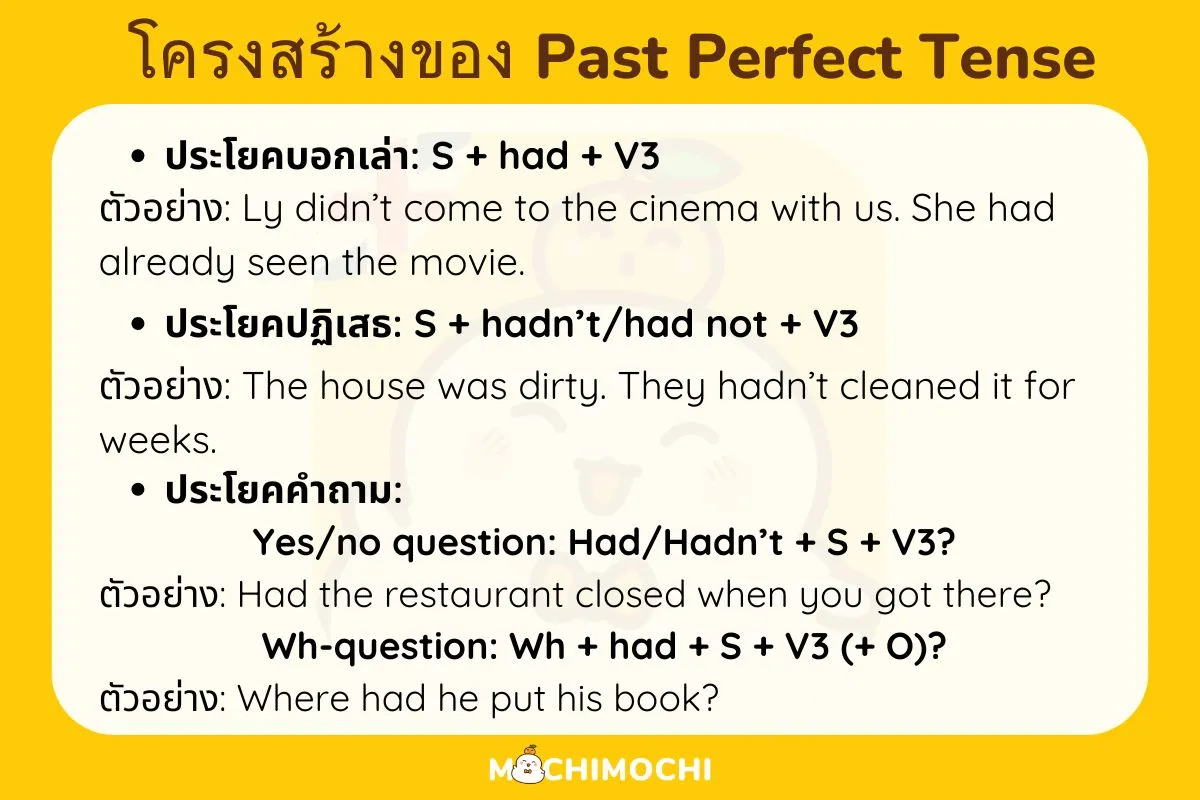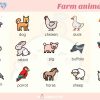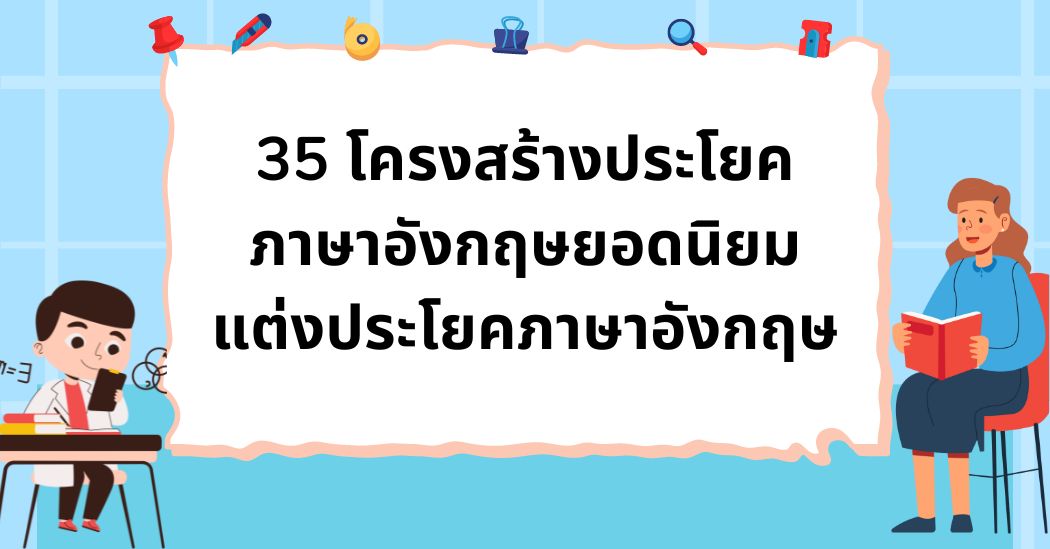หากต้องการเปลี่ยนคำกริยาให้เป็น past participle ส่วนใหญ่ให้เติม -ed หลังรูปฐานของกริยา อย่างไรก็ตาม มีคำกริยาบางคำที่มีรูป past participle ที่ไม่เป็นไปตามกฎนี้ พวกเขาเรียกว่ากริยาที่ไม่ปกติ คุณสามารถค้นหาคำกริยาที่ผิดปกติในพจนานุกรมได้ พจนานุกรมที่เชื่อถือได้ เช่น Cambridge, Oxford ฯลฯ ล้วนมีรูปแบบคำที่มีรูปแบบคำกริยาต่างกัน
แนวคิดของ Past perfect tense (Past perfect)
Past perfect tense (หรือ tense อดีตก่อนหน้า) ใช้เพื่ออธิบายการกระทำที่เกิดขึ้นก่อนการกระทำในอดีต
เรามักใช้ past simple tense เพื่ออธิบายการกระทำในอดีต คำกริยาจะอยู่ในรูปอดีต (V2)
ตัวอย่าง: Sarah arrived at the party yesterday (Sarah มาถึงงานเลี้ยงเมื่อวานนี้)
หากใช้เหตุการณ์นี้เป็นหมุดหมาย การกระทำที่เกิดขึ้นก่อนหน้านี้เราจะใช้ past perfect tense คำกริยาจะอยู่ในรูป past participle (V3) และใช้คำกริยาช่วย had
ตัวอย่าง: Yesterday, Paul had already gone home when Sarah arrived at the party. (เมื่อวานนี้ Paul ได้กลับบ้านแล้วก่อนที่ Sarah จะมาถึงงานเลี้ยง)
เคล็ดลับ:
Tenses สมบูรณ์มักใช้เพื่ออธิบายการกระทำที่เกิดขึ้นก่อนเวลาที่คุณใช้เป็นหมุดหมาย ถ้าเวลาที่ใช้เป็นหมุดหมายคือปัจจุบัน จะใช้ present perfect ถ้าเวลาที่ใช้เป็นหมุดหมายคืออดีตจะใช้ past perfect คุณสามารถใช้คุณสมบัติทั่วไปนี้เพื่อใช้กาลอย่างถูกต้องในการสื่อสารและการอธิบาย
โครงสร้างของ Past Perfect tense
โครงสร้างทั่วไปของคำกริยาใน past perfect tense คือ:
S + had + V3 (past participle – อดีตก่อนหน้า)
คุณควรจดจำคำกริยาไม่ปกติทั้งหมดนี้เพื่อให้ตอบสนองได้เร็ว ภาษาอังกฤษมีคำกริยาไม่ปกติประมาณ 600 คำ เพื่อให้จดจำทั้งหมดได้เร็วและนานที่สุด เพื่อที่จะเรียนรู้ทั้งหมดได้อย่างรวดเร็วและยาวนานที่สุด คุณสามารถใช้แอป MochiVocab ซึ่งใช้วิธี Spaced Repetition แอปจะมีฟีเจอร์ “ช่วงเวลาทอง” ที่จะคำนวณเวลาที่คุณกำลังจะลืมคำศัพท์และส่งการแจ้งเตือนให้คุณทบทวนในเวลานั้น แอปนี้ยังช่วยให้คุณมุ่งเน้นไปที่คำยากที่คุณมักลืมโดยการแบ่งคำศัพท์ที่เรียนรู้ตามระดับความจำ แต่ละระดับความจำจะมีความถี่ในการเรียนที่เหมาะสม



วิธีการผันคำกริยาในรูปอดีตสมบูรณ์
ในการนำคำกริยามาเป็น past participle ส่วนใหญ่เพียงแค่เติม -ed หลังคำกริยารูปพื้นฐาน อย่างไรก็ตาม มีคำกริยาบางคำที่มีรูป past participle ไม่เป็นไปตามกฎนี้ เรียกว่าคำกริยาไม่ปกติ คุณสามารถค้นหาคำกริยาที่เป็นคำกริยาไม่ปกติได้ในพจนานุกรม พจนานุกรมที่น่าเชื่อถือเช่น Cambridge, Oxford,.. มีส่วน word forms ที่มีรูปแบบต่างๆ ของคำกริยา
| คำกริยารูปพื้นฐาน | อดีตกาลง่าย | กริยาช่องที่สาม |
|---|---|---|
| work | worked | worked |
| eat | ate | eaten |
| go | went | gone |

ประโยคบอกเล่า
โครงสร้าง:
S + had + V3
ตัวอย่าง: Ly didn’t come to the cinema with us. She had already seen the movie (Ly ไม่ได้ไปดูหนังกับเรา เธอได้ดูหนังเรื่องนี้ก่อนหน้านี้แล้ว)
ประโยคปฏิเสธ
โครงสร้าง:
S + hadn’t/had not + V3
ตัวอย่าง: The house was dirty. They hadn’t cleaned it for weeks (บ้านสกปรก พวกเขาไม่ได้ทำความสะอาดบ้านมาหลายสัปดาห์แล้ว)
ประโยคคำถาม
โครงสร้าง:
คำถามใช่/ไม่ใช่: Had/Hadn’t + S + V3?
คำถาม Wh: Wh + had + S + V3 (+ O)?
ตัวอย่าง:
- Had the restaurant closed when you got there? (เมื่อคุณไปถึง ร้านอาหารปิดแล้วหรือยัง)
- Where had he put his book? (เขาได้วางหนังสือไว้ที่ไหน)
การใช้และตัวอย่างของ Past Perfect Tense
ต่อไปนี้เป็นการใช้ที่พบบ่อยของ Past Perfect Tense และตัวอย่างบางส่วน
Past Perfect Tense ถูกใช้เพื่อ:
- บรรยายการกระทำที่เกิดขึ้นและเสร็จสิ้นก่อนช่วงเวลาหนึ่งในอดีต
ตัวอย่าง:
We had lived in Saigon before 2001. (พวกเราเคยอยู่ที่ไซ่ง่อนก่อนปี 2001)
The film had finished before 10 o’clock last night. (ภาพยนตร์จบก่อนเวลา 10 นาฬิกาเมื่อคืนนี้)
- บรรยายการกระทำที่เกิดขึ้นและเสร็จสิ้นก่อนการกระทำอื่นในอดีต การกระทำที่เกิดขึ้นก่อนใช้ Past Perfect การกระทำที่เกิดขึ้นหลังใช้ Past Simple
ตัวอย่าง:
When I got up this morning, my friend had already left. (เมื่อตื่นขึ้นมาเช้านี้ เพื่อนของฉันก็ไปแล้ว)
After I had finished my assignment, I went to bed. (หลังจากที่ทำการบ้านเสร็จ ฉันก็เข้านอน)
- บรรยายการกระทำที่เกิดขึ้นและต่อเนื่องจนถึงช่วงเวลาหนึ่งในอดีต
ตัวอย่าง: By the time I met you I had worked in that company for 4 years. (ตอนที่เราพบคุณ เราได้ทำงานในบริษัทนั้นมาได้ 4 ปีอยู่แล้ว)
- บรรยายการกระทำที่ไม่เกิดขึ้นจริงในอดีตในประโยคเงื่อนไขประเภทที่ 3
ตัวอย่าง:
If I had enough money, I could have bought a new laptop. (ถ้ามีเงินเพียงพอ ฉันคงจะซื้อแล็ปท็อปใหม่ได้)
If I studied harder, I wouldn’t have failed my test. (ถ้าฉันเรียนหนักขึ้น ฉันคงจะไม่สอบตก)
ใช้ในบางโครงสร้างพิเศษ เช่น:
- ประโยคอธิษฐานในอดีต
ตัวอย่าง: I wished I hadn’t gone to that terrible party. (ฉันหวังว่าฉันจะไม่ไปงานปาร์ตี้ที่แย่นั้น)
- ประโยคปฏิเสธแบบ Hardly/Scarcely/Barely …. when … และ No sooner…than…
ตัวอย่าง:
Hardly had I arrived at home when it pouring rained. (ฉันเพิ่งถึงบ้านเมื่อฝนตก)
No sooner had we opened the shop than a customer came in. (ทันทีที่เราเปิดร้าน ลูกค้าก็เข้ามา)
- ประโยคเล่าถึงเหตุการณ์ใน Present Perfect Tense
ตัวอย่าง: She said that she had already eaten dinner. (เธอบอกว่าเธอได้กินอาหารเย็นแล้ว)
สัญลักษณ์การใช้ Past Perfect Tense
คุณสามารถระบุได้ว่าเมื่อใดควรใช้ Past Perfect Tense เมื่อเห็นสัญลักษณ์ดังต่อไปนี้:
- Before/after
ตัวอย่าง:
Before I got up, my mother had already made breakfast for me. (ก่อนที่ฉันจะตื่น คุณแม่ได้ทำอาหารเช้าให้ฉันเรียบร้อยแล้ว)
I watched my favorite movie after I had done housework. (ฉันได้ดูหนังโปรดของฉันหลังจากที่ทำงานบ้านเสร็จแล้ว)
- Until
ตัวอย่าง: I hadn’t believed in love until I found you. (ฉันไม่เชื่อในความรักจนกระทั่งได้พบเธอ)
- By the time
ตัวอย่าง: By the time I had come in classroom, the bell rang. (เสียงกริ่งดังขึ้นทันทีเมื่อฉันเข้าห้องเรียน)
- As soon as
ตัวอย่าง: As soon as I had gone out, my mother called me. (ทันทีที่ฉันออกไปข้างนอก แม่ของฉันโทรมา)
- By the end of + time in past
ตัวอย่าง: By the end of last night concert, I had been exhausted. (พอคอนเสิร์ตเมื่อคืนจบลง ฉันก็เหนื่อยมาก)
Tips: แทนที่จะต้องจดจำอย่างเครื่องจักรว่าจะใช้ Past Perfect Tense ก่อนหรือหลังคำเชื่อมเหล่านี้ ให้คุณระบุลำดับการเกิดขึ้นของเหตุการณ์ในบริบทที่กำลังกล่าวถึงเพื่อหลีกเลี่ยงความสับสน เหตุการณ์ที่เกิดขึ้นก่อนจะใช้ Past Perfect Tense เหตุการณ์ที่เกิดขึ้นหลังจะใช้ Past Simple Tense
- For/since: นี่เป็นสัญลักษณ์ทั่วไปของ Tense ที่สมบูรณ์แบบ
ตัวอย่าง: I had lived in this city for 12 years. (ฉันได้อาศัยอยู่ในเมืองนี้มาเป็นเวลา 12 ปีแล้ว)
แยกแยะระหว่างอดีตกาลปกติและอดีตกาลที่สมบูรณ์แบบ
อดีตกาลปกติและอดีตกาลสมบูรณ์มักจะสับสนกัน เพื่อช่วยให้คุณใช้สองกาลนี้ได้อย่างถูกต้อง มาร่วมกันมาทำความเข้าใจความแตกต่างกับ MochiMochi
| เกณฑ์ | อดีตกาลปกติ | อดีตกาลสมบูรณ์ |
|---|---|---|
| โครงสร้าง | S + V2 (+O) | S + had + V3 (+O) |
| การใช้งาน (ดูภาพประกอบเพื่อเห็นความแตกต่างชัดเจน) | อธิบายการกระทำที่เกิดขึ้นในอดีตโดยสมบูรณ์ ยุติลงแล้ว. ตัวอย่างเช่น: Paul wasn’t at the party when I arrived at 9p.m yesterday. | อธิบายการกระทำที่เกิดขึ้นก่อนการกระทำหรือเวลาอื่นในอดีต จบลงไปแล้วในอดีต ตัวอย่างเช่น: He had gone home at 8 p.m |
เคล็ดลับการเรียนรู้กาลอดีตสมบูรณ์
การบันทึกคำกริยาที่ไม่ปกติ
การเรียนรู้คำกริยาที่ไม่ปกติเป็นขั้นตอนสำคัญในการใช้กาลอดีตสมบูรณ์อย่างถูกต้อง ในการทำเช่นนี้ คุณสามารถสร้างรายการคำกริยาที่ไม่ปกติและทบทวนพวกมันทุกวัน วิธีการที่มีประสิทธิภาพได้แก่การใช้บัตรคำศัพท์ (flashcards) การสร้างประโยคตัวอย่างกับคำกริยาทุกคำ และการเข้าร่วมเกมคำศัพท์เพื่อช่วยในการจดจำได้ดีขึ้น
การฝึกฝนบ่อยๆ
การฝึกฝนเป็นกุญแจสำคัญในการเรียนรู้ไวยากรณ์ และอดีตกาลที่สมบูรณ์แบบก็ไม่มีข้อยกเว้น ควรทำแบบฝึกหัดเกี่ยวกับกาลอดีตสมบูรณ์มากๆ เพื่อช่วยให้คุณจดจำโครงสร้างและวิธีการใช้ได้ สามารถใช้สื่อการเรียนรู้ หนังสือแบบฝึกหัด หรือเว็บไซต์การเรียนภาษาอังกฤษในการค้นหาแบบฝึกหัดที่เหมาะสม นอกจากนี้ การตรวจสอบและแก้ไขข้อผิดพลาดหลังจากเสร็จสิ้นแบบฝึกหัดจะช่วยให้คุณค้นพบจุดอ่อนและพัฒนาทักษะของคุณ
การสร้างบริบท
เพื่อให้ง่ายต่อการจดจำและนำกาลอดีตสมบูรณ์ไปใช้ในชีวิตจริง ควรพยายามสร้างบริบทที่เฉพาะเจาะจง คุณสามารถแต่งประโยคหรือเขียนย่อหน้าที่ใช้กาลอดีตสมบูรณ์ ตัวอย่างเช่น เขียนเกี่ยวกับความทรงจำที่เกิดขึ้นในอดีต และใช้อดีตกาลที่สมบูรณ์แบบเพื่ออธิบายการกระทำที่เสร็จสิ้นก่อนเวลาที่กำหนด การทำเช่นนี้จะช่วยให้คุณจดจำได้ดีขึ้นและเข้าใจการใช้กาลนี้ในชีวิตประจำวันได้ดีขึ้น
การผสมผสานกับกาลอื่นๆ
การฝึกใช้กาลอดีตสมบูรณ์ร่วมกับกาลอื่นๆ ในอดีต เช่น อดีตกาลง่ายและอดีตกาลต่อเนื่องจะช่วยให้คุณเพิ่มความสามารถในการใช้กาลในภาษาอังกฤษอย่างเชี่ยวชาญ ลองเขียนย่อหน้าหรือเรื่องสั้นที่คุณใช้กาลเหล่านี้เพื่ออธิบายเหตุการณ์ที่เกิดขึ้นในอดีต การทำเช่นนี้จะช่วยให้คุณเข้าใจความแตกต่างระหว่างกาลเหล่านี้และวิธีที่พวกมันเชื่อมโยงกันในการแสดงความหมาย
แบบฝึกหัดกาลที่สมบูรณ์แบบที่ผ่านมา
แบบฝึกหัดที่ 1: ผันคำกริยาที่แนะนำเป็นรูปแบบอดีตกาลที่สมบูรณ์แบบที่ถูกต้อง
- The tornado destroyed the tent that we (build) ___.
- She (not / be) ____ to Hanoi before 2018.
- When he went out to play, he (do / already) ____ his homework.
- My sister ate all of the cake that our mum (make) ___ .
- The nurse took off the plaster that she (put on) ___ six weeks before.
- The waitress brought a drink that I (not / order) ___ .
- I could not remember the song we (learn) ___ three week before.
- The children collected mangos that (fall) ___ from the tree.
- (she / phone) ____ Nam before she went to see him in Laos?
- He (not / ride) ___ a elephants before that day.
คำตอบ:
- had built
- had not been
- had already done
- had made
- had put on
- had not ordered
- had learned
- had fallen
- had she phoned
- had not ridden
แบบฝึกหัดที่ 2: ใส่คำกริยาในวงเล็บให้อยู่ในรูปแบบที่ถูกต้อง โดยใช้อดีตที่สมบูรณ์แบบหรืออดีตที่เรียบง่าย
- Paul wasn’t at the party when I arrived. He’d gone (He / go) home.
- I felt very tired when I got home, so (I / go) straight to bed.
- The house was very quiet when I got home. Everybody (go) to bed.
- Mark travels a lot. When I first met him, (he / already / travel) around the world.
- Sorry I’m late. The car (break) down on my way here.
- We were driving along the road when (we / see) a car which (break) down, so (we / stop) to help.
คำตอบ:
- He had gone
- I went
- had gone
- he’d already travelled / he had already travelled
- broke
- we saw … had broken … we stopped
บทที่ 3 เขียนประโยคใหม่ตามคำที่ให้มา โดยผสมผสานอดีตที่เรียบง่ายและอดีตที่สมบูรณ์แบบ
- David had gone home before we arrived. (After)
- We had lunch then we took a look around the shops. (Before)
- The light had gone out before we got out of the office. (When)
- After she had explained everything clearly, we started our work. (By the time)
- My father had watered all the plants in the garden by the time my mother came home. (Before)
คำตอบ:
- After David had gone home, we arrived.
- Before we took a look around the shops, we had had lunch.
- When we got out of the office, the light had gone out.
- By the time we started our work, she had explained everything clearly.
- Before my mother came home, my father had watered all the plants in the garden.





